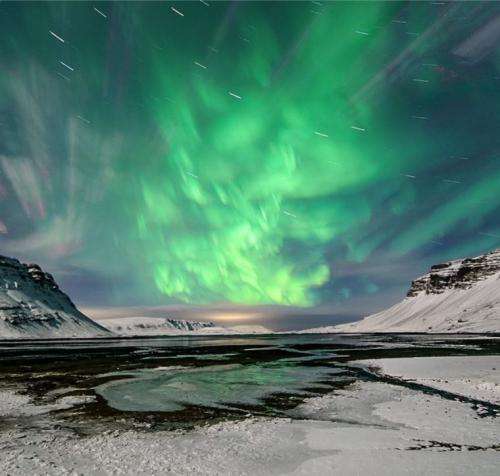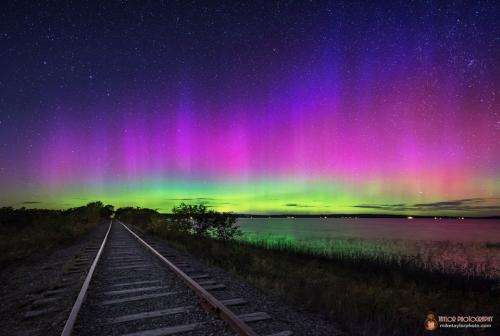What causes the northern lights?

If you live in the high latitudes, like Alaska, or New Zealand, you've probably had a chance to see an aurora. Here in Canada, we call them the Northern Lights or the Aurora Borealis, but the lucky folks in the far southern latitudes see them too. On a good night, you can see flickering sheets of light that dance across the night sky, producing an amazing display of colors. You can see green, red and even yellow and purple ghostly displays.
So what causes the Northern Lights? Auroras are in fact caused by interactions between energetic particles from the Sun and the Earth's magnetic field. The Earth is filled with liquid metal, and it rotates inside turning our planet into a giant magnet. Invisible magnetic field lines travel from the Earth's northern magnetic pole to its southern magnetic pole. This is why compasses point north, they're following the field lines produced by this giant metallic spinning goo core. Or as I like to call it "The Planetary Shield Generator", which should not be confused with the giant whirling metallic debris field orbiting the Earth which is our "Alien Invasion Shield". Which you can learn about in another episode.
So why would we need a Planetary Shield, you might ask? It is because we are perpetually under assault by our great enemy, the Sun. Our Sun is constantly releasing a flurry of energetic particles right at us. These particles are electrically charged and driven to Earth by the Solar Wind. When they encounter the Earth's magnetic field, they're forced into a spiral along the magnetic field lines. Eventually they collide with an oxygen or nitrogen atom in the Earth's atmosphere and release photons of light.
So, thanks to the spinning magnet goo core, our planetary shield converts these particles into beautiful night time displays. Although there can be auroras almost any night in the highest latitudes, we see the most brilliant auroral displays after large flares on the Sun. The most powerful flares blast a hail of particles that's so intense, auroral displays can be seen at mid and even low-latitudes. It sounds dangerous, but we're perfectly safe here, beneath our protective atmosphere and magnetic field.
You might be amazed to know that auroral displays can even make sounds. People have reported crackling noises coming from the sky during an aurora. Even though the auroras themselves are at very high altitudes, the particle interactions can happen just a few hundred meters above the ground. People have reported hearing claps and crackles during an aurora, and this has been verified by microphones placed by scientists. If you could get high up into the atmosphere, I'm sure the sounds would be amazing.
The interactions between the Sun and our planet are just another gift we get from the night sky. If you've never seen an aurora with your own eyes, you really need to add them to your bucket list. Organize a trip to northern Europe or Alaska and get a chance to see this amazing display of nature.

Source: Universe Today





















